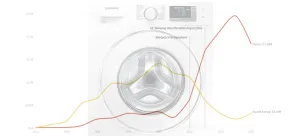
The Curious Case of South Korea's Vanishing Washing Machine Exports
The Trump administration last week announced that it planned to impose higher fees, known as tariffs, to countries that export washing machines and solar panels the United States.
The tariffs, prompted by complaints from American companies who feel disadvantaged by global trade, were applied across the world — even though they seem primarily aimed at two nations who dominate the market: China and South Korea.
That's in part because both countries have moved their manufacturing around to avoid such duties. In South Korea's case, the change in strategy by companies like LG and Samsung seems remarkably obvious in trade data — on washing machines, in particular.
A bit of background: The U.S. Census Bureau keeps detailed data on specific product exports, by country, to the United States. The data reflect the total export value by year and national origin — where the ships came from, essentially — not by companies' home countries. So Samsung products made in China and exported from China look like Chinese exports.
This graphic shows one possible scenario for how the strategy played out. Washing machine exports from South Korea to the United States dropped dramatically, for example, after a complaint filed in late 2011 by Whirlpool, an American manufacturer. A year later, exports from China increased significantly (and have since fallen, perhaps reflecting other shifts in manufacturing locations, such as Southeast Asia, Mexico and/or the United States itself).
The Times' story noted the South Korean companies' concerns:
Samsung and LG described Whirlpool’s case as a protectionist grab designed to shut out products that American consumers find more attractive, and argued that such restrictions on their products would hurt consumers by raising prices.
The export change appears to be because South Korean washing machine companies moved their operations to China during 2013 — and later the the United States — perhaps in an effort to avoid the complaints or looming tariffs. Or because the change was good business for the companies.
Anyway, the data seems pretty obvious: